My Recollection.
Oh, I hate having two heads. The ball is turning into a fat, bald guy. The turkey’s a little dry.
Look, feeling boobs is neat and all but there’s a downside to growing up. For starters, do you know how much more fun wrestling is when it’s real? Nothing compares. Imagine all the legitimate narrative present in competitive athletics—challengers battling champions, underdogs getting a shot, victory and defeat—but one of them’s a day-glow berserker covered in bike tassels and the other is a zombie controlled by a weirdly high-voiced marshmallow goth. The only thing that could have improved it would have been a video ref. These days, the most exciting thing in my life is improving my shitting via a vaguely orange flavoured powder. Back then, my reality, my really-real reality, involved a Colosseum of cartoon gods .
The critical difference between a childish imagination and a full-blown delusional disorder is that the child believes things happen, just that they’re not happening to them. Understanding that Paul Bearer’s control of the urn is what lets him dictate the actions of the far stronger Undertaker isn’t the same as seeing zombies in your yard. The line is blurred, but it’s still a line. But operating on a kind of unconscious belief that this wondrous shit is happening just out of your sight builds a kind of pressure in the mind. A pressure you don’t even know is there until something bursts it.
So it was, at age 5, that everything came pouring out—magic, zombies, Predator, Transformers—when my cat walked into the lounge one morning and said my name.
On the Big List of Things a Child would Love to Magically Happen, talking pets are pretty fucking high. When a pet talks, other adventures are sure to follow. No movie about a talking pet turns into a meandering Kevin Smith dialogue fest (original concept: do not steal). The government gets involved to harness the amazing talking cat as a spy in the notoriously cat-friendly U.S.S.R, I learn confidence, and meet a girl that gets me, maybe the cat is telekinetic? It’s a bigger deal than just a hairy conversation.
That’s what you imagine when you think about a talking cat, except my cat didn’t talk like that. It didn’t sound like Ronnie Schell, it didn’t make a quip about me eating cereal in my underwear while Aerobics: Oz Style played on the TV. My ginger cat wandered into the lounge room and yowled my name:
GAAAAEEEEE… BREEEEEEEE… AAAAAWWWWWWWWLLLLLL
The cat’s face contorted as though saying this hurt. As though it wasn’t saying it. As though something within the cat was saying it. Each syllable stretched into otherworldliness by an alien organism either still converting itself to “cat” or having to howl through vocal chords that weren’t designed for this. I was five years old, I was waiting for cartoons to come on, and now my name was the birth cry of a sickening cosmic obscenity. I couldn’t move. I sat that kind of still that animals sit when they’re hoping that if they don’t affect the universe at all then a problem massively beyond their comprehension will go away.
GAAAAEEEEE… BREEEEEEEE… AAAAAWWWWWWWWLLLLLL
The thing about the blur is that it’s a double-edged sword, one being wielded by someone with stubby little fingers and no upper body strength. Yeah, there were cool made-up things, but there were also terrifying made-up things like the music video to Thriller, the monster from Terror Vision, and Large Marge. My talking cat’s second throaty wail banished the fun stuff and summoned every horror there was.
Bravery is an interesting concept and the word means many different things to many different people. None of those things include me freaking out and yelling for my mum, but I don’t care, because haunted cat throats were screaming my name.
I still couldn’t bring myself to tell mum that the cat was talking. It wasn’t a conscious thought exactly, I just kept stopping at the “The cat!” part of “The cat is talking!” This was probably for the best. A sleeping parent worried about some as yet unidentified cat problem is going to be far more motivated to move than one who knows the talking cat problem is, at worst, something to see a child psych about.
Fortunately for me, there was something observably wrong with the cat. I was dragging mum to the lounge room to do I don’t know what about god only knows when he looked at us, weirdly meowed, and then threw up. He had some kind of giant hairball, which is a thing some cats feel the need to announce to the world, and the sounds were him trying to bring it up. It wasn’t a magic cat, it wasn’t a demon entity, it wasn’t a throat alien, it was vomit. Vomit screamed my name and broke my little brain.
Watching it steam on the linoleum, the pungent tang of vinegary digestive fluids hitting my nose, I began to doubt the marshmallow goth’s claims that the Undertaker could not be defeated.
The Episode.
There’s this thing called scale invariance and it’s the idea that something can be identical across scales whose distance from each other would make them seem entirely different. Narrative structures are, fundamentally, scale invariant. A serialised narrative series, for instance, will mirror the narrative patterns of individual episodes within the series. The early episodes will focus on exposition, establishing and building character and world. Early mid to mid episodes will present challenges for these characters and other narrative complications that build tension. Mid to late mid episodes will threaten protagonists with failure and defeat. Then the final episodes will have some giant climax, be it action or emotion, and then taper off to the denouement.
This pattern can even repeat across multiple seasons, though usually not as the commercial realities of television seldom allow for that level of planning ahead. Many shows will either be cut short due to unpopularity, overextended due to popularity, or, in the interesting case of Babylon 5, both. Even superficial variations on this pattern are just the same pattern at a different scale. Game of Thrones (when it was good) would use their penultimate episode as the climax, leaving the entire final one as the conclusion. This was done because the narrative was (ostensibly) a multi-season arc, meaning the final episodes had to act both as conclusions for a lot of threads and as light setups for the following season. Giving these their own episode gave both the space to function with the necessary emotional weight. But no matter how you spread it, it’s still the same pattern.
The Treehouse of Horror episodes illustrate this point through the opposite form of execution, having what would normally be a 21-minute pattern occur over 6 and the result is a good example of the uses of narrative density, how little is actually necessary when constructing narrative, and how to use intertextuality and tropes to hide something big inside something small.
Narrative density is the relationship between the runtime of the story and the amount of narrative in it which, combined with the story form, creates the rhythm of the narrative. Playing all the notes of a song at once doesn’t result in the song. This is because the spaces between the notes are as important, and this is true for narrative rhythm as well. A quick humorous note following a sad note will work to cancel out the heavier emotion in something that wants to maintain a lighter comedic tone. Lots of notes in quick succession will overwhelm, a technique usually used in comedies to stifle pattern recognition or joke prediction in an audience, which creates better opportunities for surprise. Conversely, leaving something alone emphasises it, like a major punchline or heartfelt moment, and this is what is referred to as letting a moment hit.
Hyman Krustofsky shouting that he has no son in Like Father, Like Clown is a lot of a sad emotion, so it is countered with a very quick absurdity that caps the scene and restores the light comic tone. Homer silently watching the stars at the end of Mother Simpson has no interruptions because the bittersweet melancholy of the moment is the point.
Mistiming rhythms can disrupt tones, corrupt the intended effect of narrative points, and is one of those “can’t put my finger on it” problems people tend to notice but not know. The sense that a resolution is brief in a manner that devalues the challenges leading to it is one that I see online a lot. Generally, this is a result of the narrative not giving the resolution point enough space either side to balance it against the combined elements leading up to it. This space doesn’t need to, and seldom will, actually match the amount that led to it, it just needs to feel like it does. Homer’s touching moment, staring at the stars, is brief, but its weight lets it satisfyingly counterpoint the length of the episode before it.
Treehouse of Horror mini-narratives are densely packed, but by stripping a lot of spare material out, they don’t wind up sounding like all the notes played at once. By itself, a short story can be, and often is, anaemic. Anthology horror stories like Creepshow run into this a bit and wind up little more than some set dressing slapped hastily onto a single idea, hoping a basic novel hook such as a twist will be enough. There’s no time to care about these soldiers, but now they’re turning into werewolves and hopefully that will be enough to carry 20 minutes of show. The Simpsons has some advantages things like Creepshow doesn’t, and it’s taking advantage of this that fleshes their tiny stories out.
Firstly, the cast is known, so no time needs to be wasted on them. Secondly, the stories are all either direct homages to existing media or use the clichéd tropes of decades old genres. Each story in this episode is based on a horror story by W.W. Jacobs, a Twilight Zone episode and movie segment, and a deranged movie called The Thing with Two Heads (itself a kind of Blaxploitation companion piece to the even more deranged The Incredible 2-Headed Transplant) respectively. Normally, this level of cliché is avoided as the resulting predictability stifles any threat the narrative conflict may have had and bores the audience, but the novelty of familiar characters in familiar if wildly unusual situations becomes the focus point, fixing the problem. So now, not only can the show lean on clichés, it’s rewarded for outright replaying classic moments as these become fun reference jokes.
Lastly, these references fill gaps in a similar fashion to the use of omission in comedy and horror, except instead of a total blank space the brain fills with a feeling, there’s a loose suggestion of form that the brain accepts as the narrative that would normally be there. A bit like a metonym or the half-seen outline of a monster in a horror film implying the creature’s presence.
The Treehouse of Horror episodes take what would normally be a twenty-one minute story and crushes it into about 6. This can seem like an impossible task, but it really just illustrates how thin the narrative skeleton is. Things like narrative density and the resulting rhythm that comes from managing that, create deeper and richer experiences, but when your episode is an extra-universal novelty, there are less pressures and some clever tricks available. Short stories can skirt details, but this does lend themselves toward overreliance on cliché to make up for the shortfall in narrative flesh. The Simpsons gets out of this with its familiar characters being put in odd but familiar situations, so there’s novelty nested comfortably within the known. What would be cliché, then, becomes comic reference, and the show is rewarded for it. The familiarity is something typically alien to short anthology stories, and The Simpsons is able to leverage this into the accepted tropes functioning as a mental gap fill for character and plot depth the time limit prohibits.
Treehouse of Horror II is, like its brethren, a fun episode. The aforementioned realities of the format means the tales can be little more than strings of gags and this doesn’t fuck the narrative because there’s nothing there to fuck. But that’s okay.
Yours in wanting a bigger board and a bigger nail, Gabriel
Jokes, lines, and stray thoughts.
Bart’s decapitated head candy bucket is fun.
I love the hollow cardboard “donk” of Lisa falling over in her costume
This is the only Halloween episode where the stories don’t get visible titles.
Lisa’s shirt has bugged me for goddamn years, even Dad, my go-to oracle for old cultural references and obscure factoids had no idea what the fuck this was about. I finally think I got it but goddamn, it is a long walk for fucking nothing. Basically, there is a thing called the “Bab Bou Jeloud” which can be transliterated into English in a variety of ways, hence the odd version of it on Lisa’s shirt. It’s an ornate gate in Morocco. The shirt is basically an “I kissed the Blarney stone” gag, with a misspelled word that struggles to find accurate representation in Latin characters and a huge waste of my life pondering about.
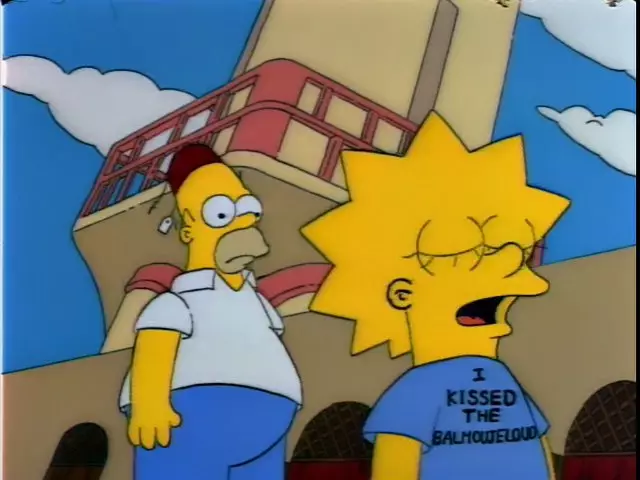
This and the tag on Homer’s fez are classic “TOURIST” signifiers.
The yogi walking away on his ears always cracked me up.
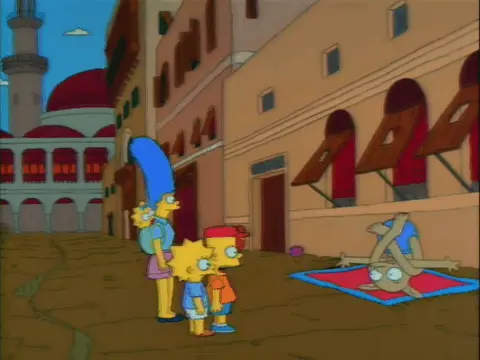
I feel like there’s a running gag of Homer not giving a shit about curses.
Bart and Lisa rubbing the camel’s knees bothers me. Like, a knee? I know it’s all the way up there but if I had a choice between rubbing something’s knee or not petting it at all, I’d choose nothing.
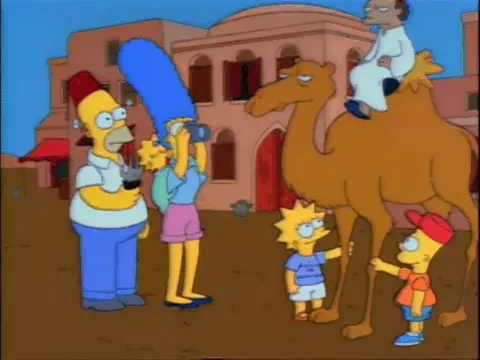
The “you’ll be so-rry” gag is a goodun, and winds up aided by the shoddy animation and lack of mouth movement.
The airport scene is a reference to Midnight Run, a film based on a book about a guy getting busted trying to smuggle hash out of Turkey. In any other episode, it wouldn’t quite stand out as much, but it eats a bunch of the really small amount of time the story has and the gag really isn’t worth it. Ultimately, it’s a reference building to a gag about currency conversions.
“There’s something I don’t like about that severed hand” is a goodun.
Maggie’s wish is solid, the car tearing off after the pacifier is a good combination of audio and visual capping the gag.
The Simpsons being rich and famous is a fairly, sadly, accurate parody of the early days of the show.
Bart’s mammogram poster is funny.
While there’s little to functionally critique about the episode’s plot, this first story is meant to be Lisa’s dream, but she is a minor character in it. If anything, it’s a Homer story, which is weak when he’s a primary character in the second and the focal character of the third. The whole thing smacks of “can’t write for Lisa”-itis.
Kang and Kodos became Halloween regulars after this episode. Committing to something far larger than you were expecting it to be on a whim speaks to me for some reason.
Homer’s wish is such a beautiful moment. Completely understandable, he just wants something to work as advertised and his breakdown over the dry turkey is one of those great things where a tiny thing is the collapse point that brings the rest of the stresses down upon you. “The turkey’s a little dry” was one of the oral memes we got from this era.
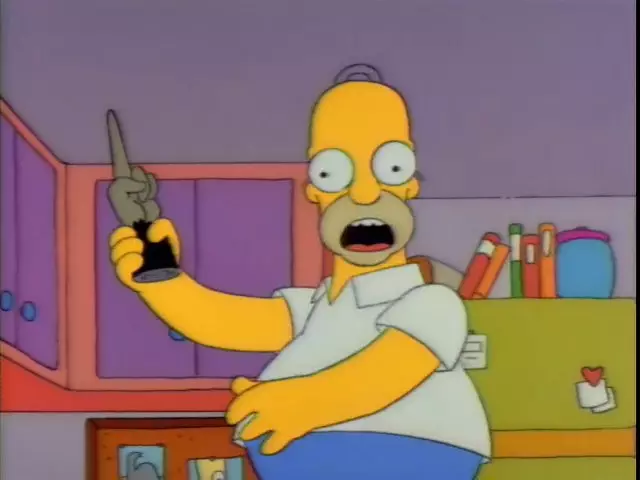
I do wonder if the monkey’s paw backfired on Flanders of if his successful use of it was a continuation of its curse on Homer.
Kang taking off his crown and sash as he talks is a fun bit of normality amidst the ridiculousness that stands out as a great counter joke.
This whole story reminds me a bit of when comedians do those comedy debates but don’t have anything really to say on the debate topic, so they just do their routines with a somewhat pathetic connection at the end. The tag of this episode, the marginally funny Homer wishing for a monkey’s paw, leads to Lisa needing to sleep with Bart as this “nightmare” was simply too extreme to handle. Each of the other stories ends on a sharp moment that leads to the character waking up screaming. I almost wish they did that with this episode as, daft as it would have looked, at least there’d have been something.
The actual candy parts of a candy necklace are only slightly more edible than the string.
The original Twilight Zone episode, It’s a Good Life and the updated segment from the movie are both good. The original Anthony wasn’t a good actor, but that actually wound up fitting the story perfectly. His clumsy childishness added more unthinking menace to the situation. He was pure whim, couldn’t be reasoned with. The jack-in-the-box bit is taken from this. The movie segment is cartoony, surreal, and has some great effects work. It leans more toward the shocking rather than the creepy and does so quite well. Nancy Cartwright has her mouth disappeared in the film. There’s also a sequel episode It’s Still a Good Life from the 2002 run, but I haven’t seen it.
Rod Serling was a great creator and I recommend finding interviews with him.
Jasper the dog is a great reference to Invasion of the Body Snatchers, the ’78 version, which is a fairly great film.
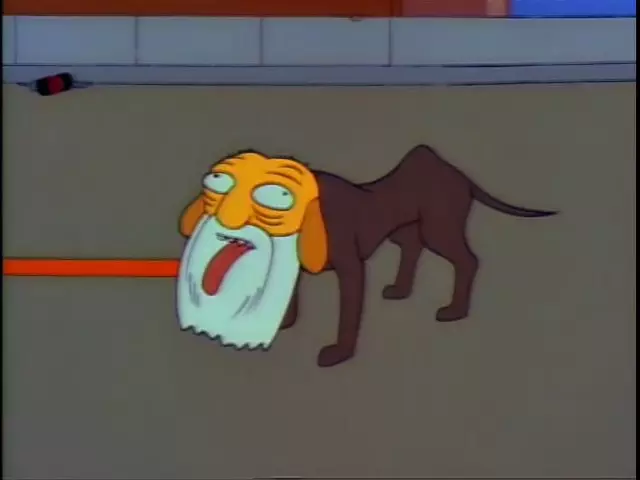
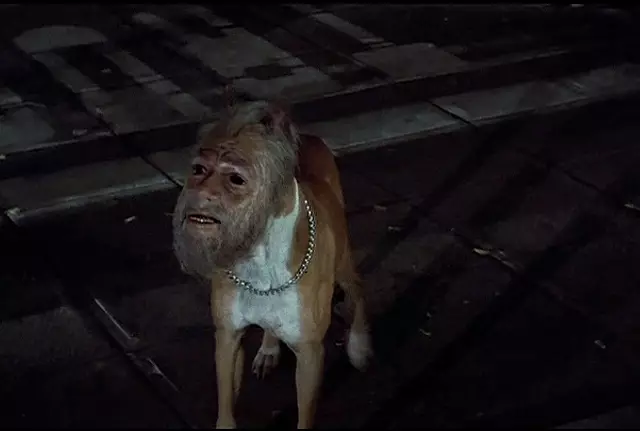
Better Snowball II is a goodun, a reference to Duck Amuck, apparently. In the original, Anthony was making various monsters that we never saw.
“The ball is turning into a fat, bald guy” is a classic. Reverse surprise style joke, presenting as normal something that’s not.
Homer’s inner monologue as he’s creeping up on Bart is great. The whole scene being focused on Homer’s head is actually a great use of cinematography to communicate a mind that is so screamingly easy to read that any of us could do it.
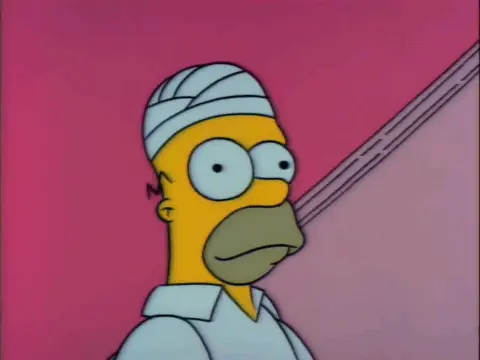
Bart is a more whole person than Anthony, and so he still cares about his mother’s admonitions.
Bart has no tongue during his scream.
“You both toilet trained?” and the indignant response is a nice gap fill joke.
I love Burns’ terms for lazy employees, slugabed, real word.
Burns’ story is a good example of something that’s really mostly a trope compilation rather than a direct reference to anything specific. There’re elements of Frankenstein in here, and the The Thing with Two Heads pops up in the conclusion, but otherwise it’s just a hodgepodge of basic sci-horror bits and pieces. Approaches like this are good ways to do homages as it helps keep you from devolving into parody, like how Shawn of the Dead is based on zombie movies and not a zombie movie.
“The greatest breakthrough in labour relations since the cat-o-nine-tails” is a great Burns line.
I still laugh my ass off at the scene with Smither’s dragging the bag of Homer through the graveyard. The noises he makes, the fact that he doesn’t wake up, the comically overdone walloping that Burns, in a non-canon display of strength, give him, and the defeated whimper that seeps from the sack once it’s over. All that and he still doesn’t die. “STOP SCARING SMITHERS” still gets me. A nice run of little things that add up.

The fact that the robot already looks like Homer can work fine in comedy but tells like this are poison to anything serious. It’s a small but distinct pile of suck when the alien fire monsters just happen to be named using Latin terms for fire. It’s lazy writing, don’t fucking do it.
“Take out that brain and flush it down the toilet.” Burns, when he’s got room to flex, can be a lot of fun.
“I owe you a coke” is great, both as a trivial bet over something so serious and because it gets referenced in The Shinning
There’s exactly zero coherence for Burns’ head actually being on Homer’s body, save the narrative jumping from the end of Halloween to some days for no other reason than surprise. A good example of something like this working would be season 1 of Westworld where there were two concurrent narrative periods. This was valid as one was explaining relevant character elements of the other. Generally, because the narrative is god, creating surprise by simply denying your audience the information they need is shitfully bad.
The “Next week on The Simpsons” bit and the line “I hate having two heads” were burnt into my head when I was young. It’s kind of an odd cap to the episode, weirdly self-aware, and that stood out as it was fairly rare at the time.
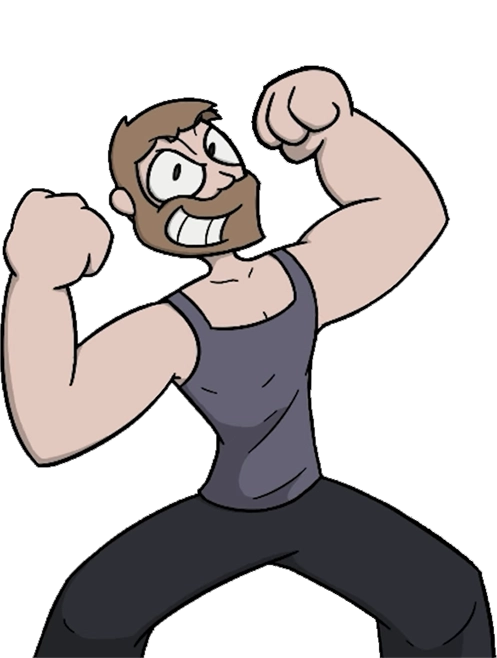

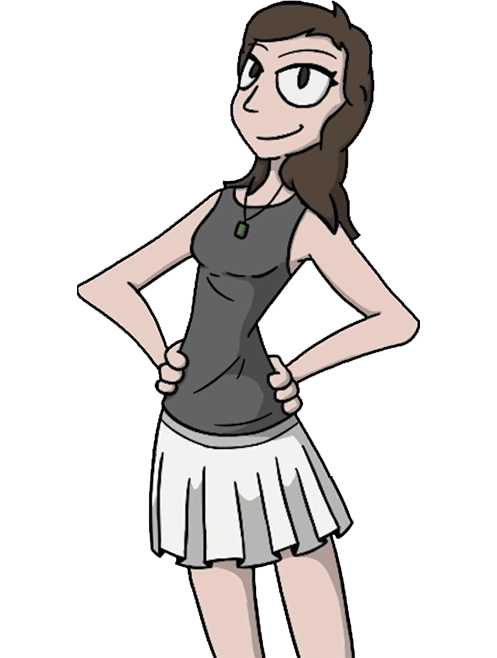
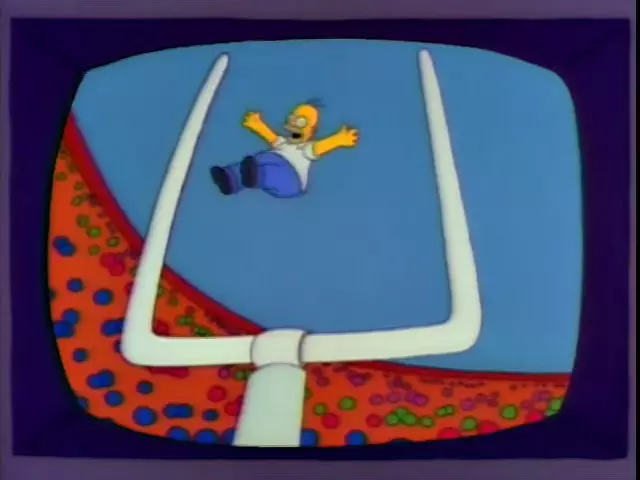

3 replies to Treehouse of Horror II
Magnumweight on 24th November 201924 Nov 19 said:
"Lisa that was very selfish" is just peak Homer, even though I'm sure Lisa did do it to feel better about herself.
The way Homer's head sways as he's screaming after Bart transforms him has always given me the significant Williams, even today.
I'm pretty sure the coke bet comes back net year in the King Kong story
Gabriel on 24th November 201924 Nov 19 said:
I think you're right about the coke.
Magnumweight on 9th December 201909 Dec 19 said:
Recently watched ToH 3 and it didn't come up, I guess I just remembered wrong.
Comment on Treehouse of Horror II
To reply, please Log in